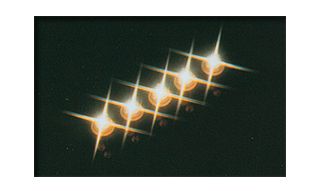
White light, white heat
Highly-efficient, cost-effective white light-emitting diodes (WLED) can replace inefficient, polluting kerosene lamps common in the developing world, and in off-grid situations, saving tens of billions of dollars per year worldwide, according to a scientist at the U.S. Department of Energy’s Lawrence Berkeley National Laboratory (Berkeley Lab).
Evan Mills, of Berkeley Lab’s Environmental Energy Technologies Division, notes in an article in the May 27, 2005 issue of the journal Science that more than 1.6 billion people have no access to electricity, and many others have only intermittent access. As a result, those who can afford illumination when it’s dark rely on lamps that burn kerosene, diesel, propane, or biomass-based fuels.
 White LED flashlight with batteries. BUY FROM AMAZON
White LED flashlight with batteries. BUY FROM AMAZON
In his Science article, Mills proposes a lighting option that developing nations might use to reduce the cost of providing effective, cleaner lighting to their citizens. “As they modernize, developing countries can select better technologies, and in so doing surpass levels of efficiency typical of industrialized nation. The latest improvement is the solid-state white light-emitting diode.” In recent years, R&D performed by private industry as well as the Department of Energy has made these light sources suitable for task illumination.
Mills also points out that LED systems are rugged, portable, use direct current, have long service lives, and run on widely available “AA” and “AAA” batteries.
“Evaluated in terms of total cost of ownership, (purchase plus operation), WLED systems emerge as the most cost-effective solution for off-grid applications,” says Mills. He estimates that solar-powered WLEDs could appear on the market for $25 without need for subsidy. The annual fuel saving for each lantern is on the order of a month’s income for the poorest one billion people of the world, who often subsist on less than $1 a day.
 ULTRABRIGHT WHITE 5mm LED – BUY IT FROM AMAZON
ULTRABRIGHT WHITE 5mm LED – BUY IT FROM AMAZON
According to Mills, the problem of fuel-based lighting has been largely ignored by the energy policy community. Important next steps include more in-depth assessment of the opportunity, designing and field-testing affordable high-performance systems for various applications (e.g. reading, cottage industry, schools, and general social interaction), mounting pilot programs, and developing viable business models for reaching the target markets.
“Studies show that illumination, one of the core end-use energy services sought by society, is available to people in industrialized countries at 1,000 times more energy efficiency than for the un-electrified poor in the developing world,” Mills says. Fuel-based sources, such as a wick lantern, generate one-500th the illumination of electric light sources, and their energy efficiency is much lower.
Mills estimates that fuel-based lighting throughout the world consumes 77 billion liters of fuel annually, at a total cost of $38 billion per year, or $77 per household. This, he says, is equivalent to 1.3 million barrels of oil per day, roughly the total oil production of Indonesia, Libya, or Qatar, or half the total oil production of pre-war Iraq.
A single fuel-based lamp used four hours per day emits more than 100 kilograms of carbon dioxide into the atmosphere each year. Mills calculates that fuel-based lighting is responsible for about 190 million metric tons of carbon dioxide per year, equivalent to one-third the total emissions from the United Kingdom.
Despite these large numbers, un-electrified households receive much less light for their money than those in the industrialized world. Kerosene and other fuel-based lighting represents 17 percent of global lighting energy costs, according to Mills, but only 0.1 percent of lighting energy services, measured in terms of lumen-hours. The cost per unit of kerosene-based lighting is about 150 times higher than the highest efficiency fluorescent lamps.
High-efficiency LEDs provide white light, and the technology is improving as manufacturers devise products with higher light output and energy efficiencies, and lower cost per unit output. “Efficiencies of only 5 lumens per watt in the mid-1990s,” writes Mills, “are moving towards 100 lumens per watt (compared to 0.1 lumen per watt for a flame-based lantern). Commercially available 1-watt WLEDs require 80 percent less power than the smallest energy-efficient compact fluorescent lamps and can be run on rechargeable batteries charged by a solar array the size of a paperback novel.” Such LEDs could actually deliver more light to tasks than even 100-watt light bulbs.
– – – –
CONTACT: Allan Chen, 510-486-4210; a_chen@lbl.gov
TECHNICAL CONTACT: Evan Mills, 510-486-6784; emills@lbl.gov
